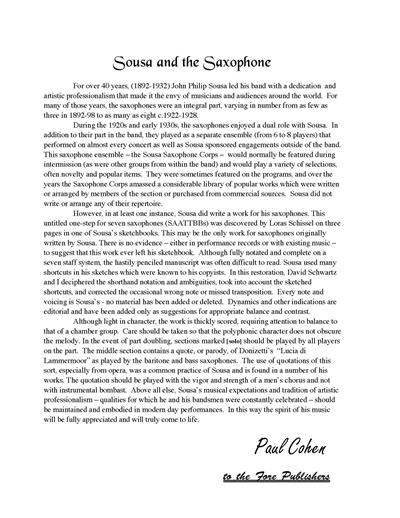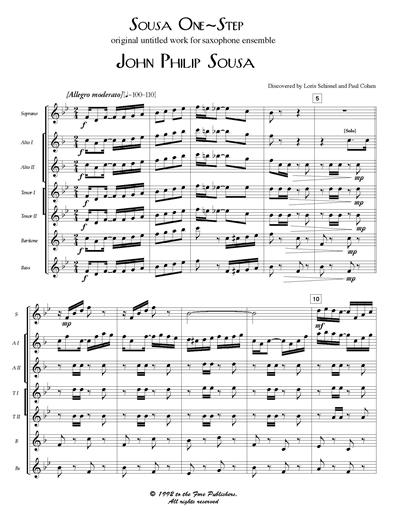John Philip Sousa- untitled one-step
For over 40 years, (1892-1932) John Philip Sousa led his band with a dedication and artistic professionalism that made it the envy of musicians and audiences around the world. For many of those years, the saxophones were an integral part, varying in number from as few as three in 1892-98 to as many as eight c.1922-1928.
During the 1920s and early 1930s, the saxophones enjoyed a dual role with Sousa. In addition to their part in the band, they played as a separate ensemble (from 6 to 8 players) that performed on almost every concert as well as Sousa sponsored engagements outside of the band. This saxophone ensemble "the Sousa Saxophone Corps" would normally be featured during intermission (as were other groups from within the band) and would play a variety of selections, often novelty and popular items. They were sometimes featured on the programs, and over the years the Saxophone Corps amassed a considerable library of popular works which were written or arranged by members of the section or purchased from commercial sources. Sousa did not write or arrange any of their repertoire.
However, in at least one instance, Sousa did write a work for his saxophones. This untitled one-step for seven saxophones (SAATTBBs) was discovered by Loras Schissel on three pages in one of Sousa's sketchbooks. This may be the only work for saxophones originally written by Sousa. There is no evidence either in performance records or with existing music to suggest that this work ever left his sketchbook. Although fully notated and complete on a seven-staff system, the hastily penciled manuscript was often difficult to read. Sousa used many shortcuts in his sketches which were known to his copyists. In this restoration, David Schwartz and I deciphered the shorthand notation and ambiguities, took into account the sketched shortcuts, and corrected the occasional wrong note or missed transposition.
Every note and voicing is Sousa's - no material has been added or deleted. Dynamics and other indications are editorial and have been added only as suggestions for appropriate balance and contrast.
Although light in character, the work is thickly scored, requiring attention to balance to that of a chamber group. Care should be taken so that the polyphonic character does not obscure the melody. In the event of part doubling, sections marked [solo] should be played by all players on the part. The middle section contains a quote, or parody, of Donizetti's "Lucia di Lammermoor" as played by the baritone and bass saxophones. The use of quotations of this sort, especially from opera, was a common practice of Sousa and is found in a number of his works. The quotation should be played with the vigor and strength of a men's chorus and not with instrumental bombast. Above all else, Sousa's musical expectations and tradition of artistic professionalism qualities for which he and his bandsmen were constantly celebrated should be maintained and embodied in modern day performances. In this way the spirit of his music will be fully appreciated and will truly come to life.
Paul Cohen


To Order offline:
Please include $4.00 postage and handling for each order.
Make checks payable to Paul Cohen and mail to:
Paul Cohen
To The Fore Publishers
420 Lantana Ave
Englewood, NJ, 07631